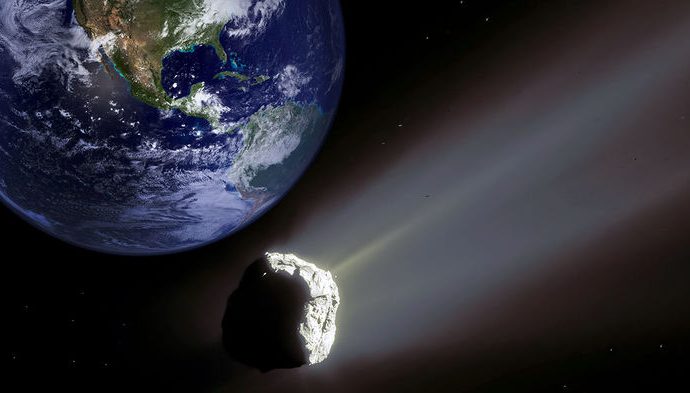Engineers have come up with a plan to purposefully steer asteroids into Earth’s atmosphere and mine them for resources in orbit. What could possibly go wrong?
Forget deflecting asteroids from hitting Earth—some engineers are drawing up a strategy to steer asteroids toward us, so our atmosphere can act as a giant catching mitt for resource-rich space rocks. What might sound like a crazy idea is actually quite business savvy, according to Minghu Tan, a Ph.D. student at the University of Glasgow in the United Kingdom who co-authored the new study. That’s because such near-Earth asteroids can host supplies, such as water and precious metals, that could support future human missions to space. But other scientists are skeptical that the concept will ever get off the ground.
The study involves aerobraking, or using the drag created by Earth’s atmosphere to slow down the path of an incoming object. Aerobraking isn’t new—every incoming spacecraft to Earth uses it to slow itself down before landing, and probes to other planets, such as the European Space Agency’s Venus Express and ExoMars missions, have also used the technique.
In the new paper, Tan and colleagues propose using aerobraking to slow small asteroids enough that they don’t just shoot straight past Earth, but stay in orbit, where they could be mined for platinum or water. Those resources could then be taken to space stations to supply future missions or operations. Water, they write, could even be split into hydrogen and oxygen for fuel. All it would take is a precisely calculated push from an unmanned spacecraft, they report this month in Acta Astronautica.
And if the maneuver were done far enough from Earth—millions of kilometers, in most cases—it likely wouldn’t take much effort. That’s because a small push from far away would greatly change the angle of an incoming space rock’s path. Tan notes that each case would be different, depending on the trajectory of the target asteroid, and says that modifications might be necessary if the asteroid gets off track.
“I think it’s a grand gesture,” says astronomer Sherry Fieber-Beyer, who was not involved in the study. But the director of the University of North Dakota’s space studies observatory in Grand Forks adds that although it’s a neat idea, “You can make anything look great on paper.”
She says that although the trajectories of many near-Earth asteroids are relatively well known, their composition is not. Metal and other dense materials react differently than lighter rocks, making it critical to understand the makeup of any potential targets. “If it’s made out of solid iron, you won’t be able to slow that sucker down,” Fieber-Beyer says. And what might appear at a distance to be an asteroid could actually be nothing more than packed rubble.
According to Feiber-Beyer and physicist Ingo Mueller-Wodarg, who studies planetary atmospheres at Imperial College London, another potential problem is that asteroids are not perfect spheres. An object with an odd shape could wobble unpredictably in orbit. “The risk would lie in the asteroid having an irregular shape and hence experiencing torque, beginning to spin and hence go out of control,” Mueller-Wodarg says. “When we do aerobraking with satellites, we carefully fire small rockets to keep [them] on course and compensate for any such wobble.”
But the biggest risk, Mueller-Wodarg and Fieber-Beyer say, would be causing an asteroid to crash into Earth, possibly causing widespread death and destruction. Tan disputes that charge, noting the paper looked only at asteroids smaller than 30 meters in diameter, which would vaporize as soon as they hit the lower atmosphere. He acknowledges that extra care would be needed if an asteroid were made of a denser material like iron, which might not burn up completely.
Tan’s team doesn’t have any particular clients in mind, but he says that companies such as Deep Space Industries and Planetary Resources have plans to eventually capture and mine asteroids. They’ll have plenty to choose from, Tan says—more than 1000 near-Earth asteroids fit his team’s size requirements.
Of course, the idea of purposely steering anything larger into Earth’s orbit might have some detractors—just ask the dinosaurs.
Source: Science Magazine

































Leave a Comment
You must be logged in to post a comment.